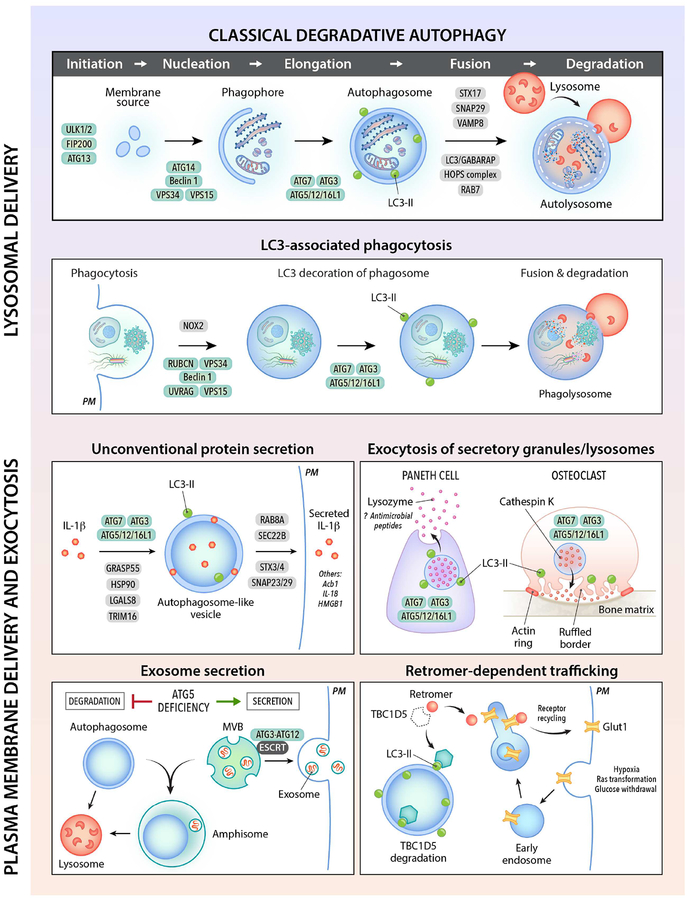Cellula.10 gennaio 2019;176(1-2):11-42. doi: 10.1016/j.cell.2018.09.048.
Beth Levine 1,
Guido Kroemer 2 Affiliazioni
- 1Center for Autophagy Research, Department of Internal Medicine, University of Texas Southwestern Medical Center, Dallas, TX 75390, USA; Howard Hughes Medical Institute, University of Texas Southwestern Medical Center, Dallas, TX 75390, USA; Dipartimento di microbiologia, University of Texas Southwestern Medical Center, Dallas, TX 75390, USA. Indirizzo elettronico: beth.levine@utsouthwestern.edu.
- 2Equipe 11 labellisée par la Ligue contre le Cancer, Centre de Recherche des Cordeliers, 75006 Parigi, Francia; Piattaforme di biologia cellulare e metabolomica, Gustave Roussy Cancer Campus, 94805 Villejuif, Francia; INSERM, U1138, 75006 Parigi, Francia; Université Paris Descartes, Sorbona Paris Cité, 75006 Parigi, Francia; Université Pierre et Marie Curie, Sorbonne Université, 75006 Parigi, Francia; Pôle de Biologie, Hôpital Européen Georges Pompidou, AP-HP, 75015 Parigi, Francia; Karolinska Institute, Department of Women's and Children's Health, Karolinska University Hospital, 17176 Stoccolma, Svezia. Indirizzo elettronico: kroemer@orange.fr.
Astratto
La via di degradazione lisosomiale dell'autofagia svolge un ruolo fondamentale nell'omeostasi cellulare, tissutale e dell'organismo ed è mediata da geni correlati all'autofagia (ATG) evolutivamente conservati. Esistono legami eziologici definitivi tra le mutazioni nei geni che controllano l'autofagia e le malattie umane, in particolare i disturbi neurodegenerativi, infiammatori e il cancro. L'autofagia mira selettivamente agli organelli disfunzionali, ai microbi intracellulari e alle proteine patogene e le carenze in questi processi possono portare alla malattia. Inoltre, i geni ATG hanno diversi ruoli fisiologicamente importanti in altre vie di segnalazione e traffico di membrana. Questa recensione discute le funzioni biologiche dei geni dell'autofagia dal punto di vista della comprensione - e potenzialmente dell'inversione - della fisiopatologia della malattia umana e dell'invecchiamento.
Copyright © 2018 Elsevier Inc. Tutti i diritti riservati.
Dichiarazione di conflitto di interessi
DICHIARAZIONE DI CONFLITTO DI INTERESSI
BL è un co-fondatore scientifico di Casma Therapeutics, Inc. GK è un co-fondatore scientifico di Samsara Therapeutics, Ltd.
Figure 1.. Autophagy gene-dependent membrane trafficking pathways. Shown are schematic illustrations of different membrane trafficking pathways that involve autophagy (ATG) proteins (green ovals). See text for explanations of each pathway and a discussion of their physiological functions. See Table 1 for examples of genetic mutations that impair autophagy-related pathways which are associated with human disease. The major type of autophagy, macroautophagy, is labeled as “classical degradative autophagy” to distinguish it from other trafficking pathways that utilize overlapping ATG proteins. Due to space limitations, not all ATG proteins, proteins involved in vesicle fusion, or secretary cargo are depicted. PM, plasma membrane. LC3-II (green circle) is the phosphatidyl-ethanolamine-conjugated form of the autophagy protein, LC3.
 Figure 2.. Conceptual overview of selective autophagy. Shown are the diverse cargoes that are degraded by autophagy and the major known mechanisms by which cargo are attached to LC3 or GABARAP family members on the phagophore membrane. Also listed are currently known organelle-specific LC3/GABARAP-binding proteins, tags that label cargo destined for selective autophagic degradation, LC3/GABRAP-binding adaptor proteins, and factors that regulate the recognition of cargo by adaptors or LC3/GABARAP. Organelle-specific LC3/GABARAP-binding proteins and LC3/GABARAP-binding adaptor proteins interact with LC3/GABARAP via conserved W/F/YxxL/I/V motifs. See Table 2 for information about different types of selective autophagy and their possible roles in physiology and disease.
Figure 2.. Conceptual overview of selective autophagy. Shown are the diverse cargoes that are degraded by autophagy and the major known mechanisms by which cargo are attached to LC3 or GABARAP family members on the phagophore membrane. Also listed are currently known organelle-specific LC3/GABARAP-binding proteins, tags that label cargo destined for selective autophagic degradation, LC3/GABRAP-binding adaptor proteins, and factors that regulate the recognition of cargo by adaptors or LC3/GABARAP. Organelle-specific LC3/GABARAP-binding proteins and LC3/GABARAP-binding adaptor proteins interact with LC3/GABARAP via conserved W/F/YxxL/I/V motifs. See Table 2 for information about different types of selective autophagy and their possible roles in physiology and disease.
 Figure 3.. Diverse biological functions of autophagy genes contribute to their roles in the regulation of mammalian disease. Shown are the major known biological functions of ATG genes and the broad categories of diseases that they regulate as predicted based on mouse experimental data and human genetic associations. Below major disease categories, some representative specific diseases are noted. Many other examples exist but are not shown due to space limitations.
Figure 3.. Diverse biological functions of autophagy genes contribute to their roles in the regulation of mammalian disease. Shown are the major known biological functions of ATG genes and the broad categories of diseases that they regulate as predicted based on mouse experimental data and human genetic associations. Below major disease categories, some representative specific diseases are noted. Many other examples exist but are not shown due to space limitations.




